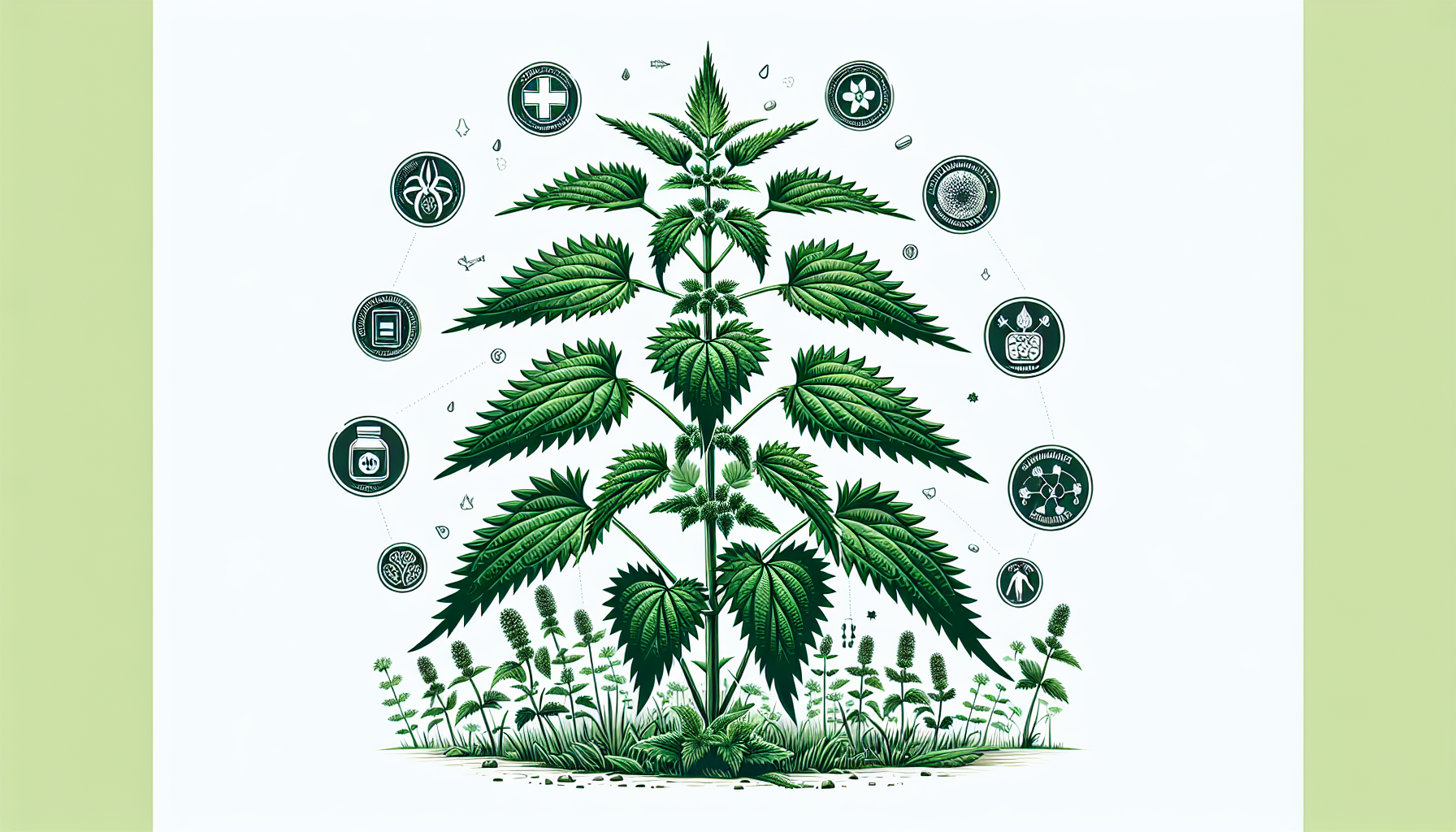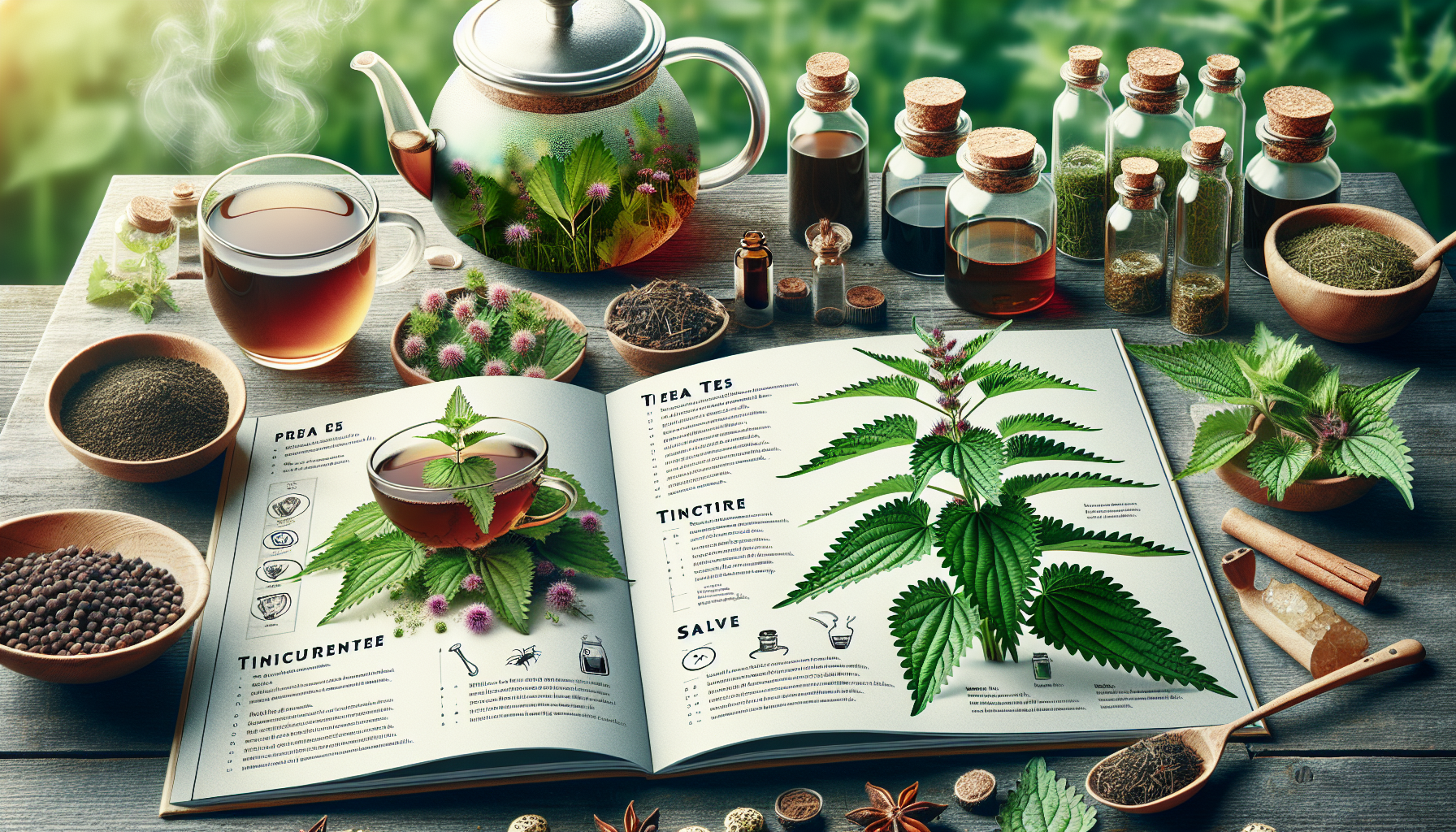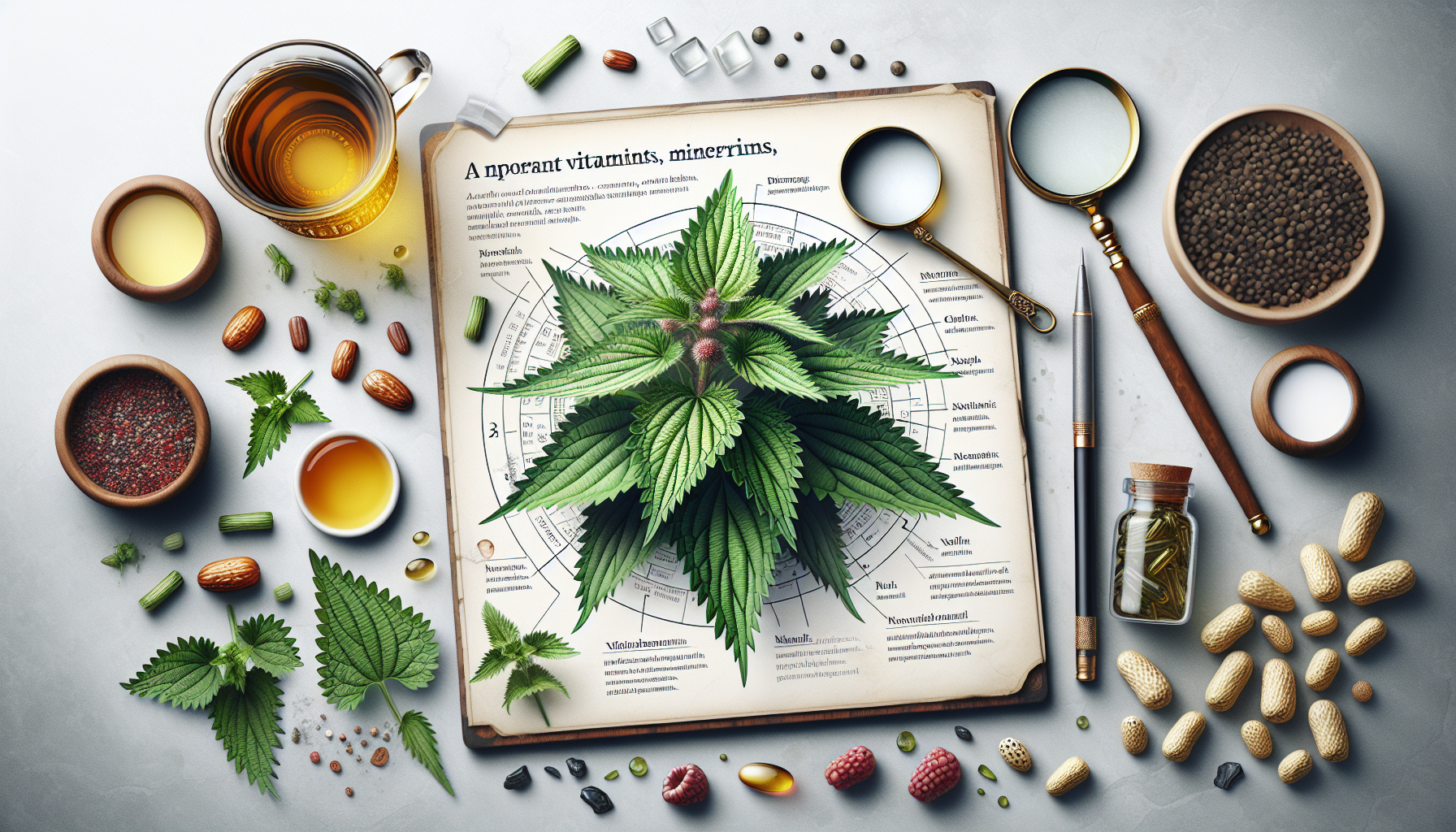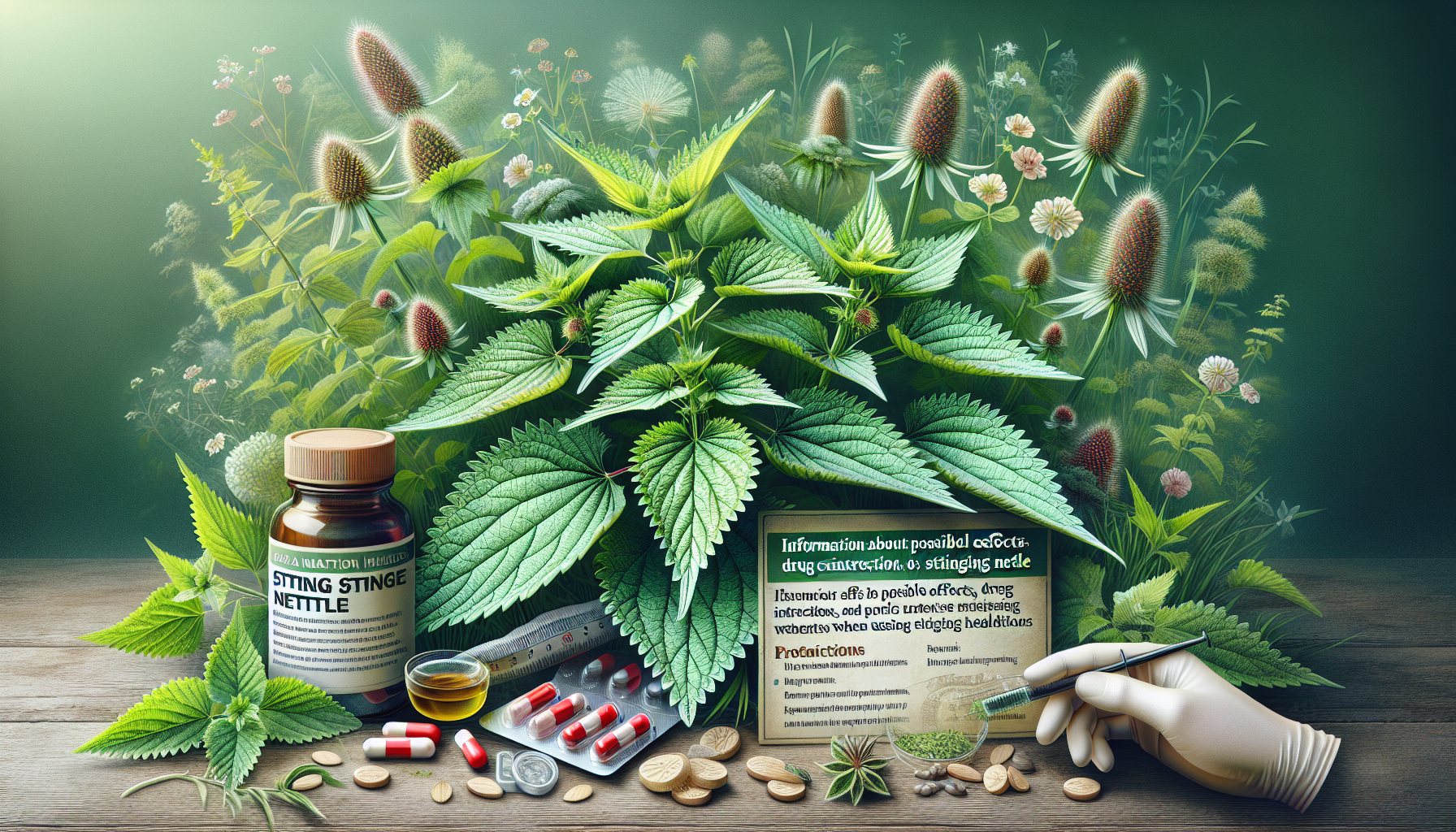The nettle in naturopathy
1. Introduction to Stinging Nettle Stinging nettle, scientifically known as Urtica dioica, is one of the most famous and versatile plants in naturopathy. It belongs to the nettle family (Urticaceae) and is an herbaceous, perennial flowering plant that grows in many parts of the world. Although it is often viewed as a pesky weed that causes unpleasant skin irritation when touched, nettle has enormous potential as a medicinal and useful plant. Their uses range from traditional medicine to nutrition to textile production. In this section, we take a look at the botanical properties, distribution and fascinating features of this underrated plant. …

The nettle in naturopathy
1. Introduction to nettle
The nettle, scientifically calledUrtica dioicaknown, is one of the best known and most versatile plants in natural medicine. It belongs to the nettle family (Urticaceae) and is an herbaceous, perennial flowering plant that grows in many parts of the world. Although it is often viewed as a pesky weed that causes unpleasant skin irritation when touched, nettle has enormous potential as a medicinal and useful plant. Their uses range from traditional medicine to nutrition to textile production. In this section, we take a look at the botanical properties, distribution and fascinating features of this underrated plant.
Botanically speaking, the nettle is a perennial plant that can reach a height of 10 to an impressive 300 centimeters, depending on the species, location and nutrient supply. The Great Nettle (Urtica dioica) and the small nettle (Urtica urens) are the most common representatives of this genus in Germany. Species such as the reed nettle (Urtica kioviensis) or the pill nettle (Urtica pilulifera). The plant often grows in dense stands and, in perennial species, forms rhizomes that are used to spread and survive. Its leaves are arranged oppositely on the stem, 3 to 20 centimeters long, with a strongly serrate edge and a heart-shaped base. The small, greenish or brownish flowers are organized in dense, axillary inflorescences and are pollinated by the wind.
A characteristic feature of the nettle is its stinging hairs, which can be found on leaves and stems - especially on the top of the leaf. These long, single-celled tubes break when touched and release a fuel that contains, among other things, formic acid, histamine, serotonin and acetylcholine. This mixture causes the typical stinging and burning sensation on the skin that many of us remember from childhood. The stinging hairs serve as a protective mechanism for the plant against predators and make it unattractive to many animals. Nevertheless, stinging nettles are an important food plant for the caterpillars of around 50 species of butterflies, which have adapted to this defense strategy.
In terms of its distribution, the nettle is almost a global resident. Originally native to Europe, temperate Asia and northwest Africa, it has now spread worldwide - with the exception of Antarctica. It is particularly common in Northern and Central Europe and Asia, while it is less common in Southern Europe and North Africa. It is also widespread in North America, with the exception of Hawaii, and it even grows in parts of northern Mexico. The plant prefers moist, nutrient-rich soil and is often an indicator of fertile locations. It is often found on river banks, in forests, in meadows or near human settlements, where it benefits from disturbed soils. In China alone there are 14 different species of the genusUrticaknown, which underlines the enormous adaptability of this plant.
In addition to its widespread distribution, the nettle is also known for its impressive nutrient density. It contains a variety of vitamins such as A, C, K and several B vitamins as well as minerals such as calcium, iron, magnesium, phosphorus, potassium and sodium. It also contains essential amino acids, fatty acids such as linoleic acid and polyphenols such as quercetin and caffeic acid. These ingredients make nettle not only a valuable source of nutrition, but also a plant with antioxidant properties that can protect cells from damage caused by free radicals. You can learn more about the health benefits in the following sections of this article, but it is already clear here why nettle has been valued in traditional medicine for centuries ( Healthline ).
Historically, nettle was used by the ancient Egyptians and Roman soldiers, including to treat arthritis and back pain. Their versatility is also evident in their use as food – young, cooked shoots are edible and rich in nutrients – and in textile production, where their bast fibers were made into fabric. This long tradition of use is reflected in numerous cultures and makes the nettle a fascinating object of natural medicine. In the coming sections, we will delve deeper into its medicinal uses, preparation options, and precautions to paint a comprehensive picture of this remarkable plant.
2. Healing properties of nettle

The nettle (Urtica dioica) is much more than just an annoying weed that burns when touched. It is a veritable treasure trove of natural medicine, valued for its healing properties for centuries. From the ancient Egyptians to Roman soldiers, it was used to treat ailments such as arthritis and back pain. Today, scientific studies confirm many of the traditional effects and uncover new potential. In this section, we explore the health benefits of nettle, particularly its anti-inflammatory, detoxifying and immune-boosting properties, and take a look at the underlying ingredients and current research.
A central aspect of the healing effects of nettle lies in its impressive nutrient density. The plant is rich in vitamins such as A, C and K as well as several B vitamins. It also contains a variety of minerals, including calcium, iron, magnesium, phosphorus, potassium and sodium. There are also essential amino acids, fatty acids such as linoleic acid and polyphenols such as quercetin and caffeic acid. These ingredients give nettle powerful antioxidant properties that can protect cells from free radical damage. The high content of vitamin C and flavonoids in particular supports the immune system by strengthening the immune system and promoting the body's regeneration. Nettle can serve as a natural health booster, especially during times of increased stress or seasonal colds.
One of the most frequently cited properties of nettle is its anti-inflammatory effects. Studies on animals and in test tubes have shown that extracts of the plant can reduce inflammatory markers in the body. In human studies, nettle has been found to relieve pain from arthritis, a use that was known in ancient times. This effect is attributed to the polyphenols and other bioactive compounds it contains, which inhibit inflammatory processes in the body. Also interesting is the traditional method of urtication, in which fresh nettles are deliberately applied to the skin to treat rheumatic complaints. Although this practice seems unusual, some users report relief from the stimulating effects of the stinging hairs, which promote blood circulation.
In addition to its anti-inflammatory effects, nettle is also said to have detoxifying powers. It acts as a natural diuretic, meaning it promotes urine excretion and thus supports kidney function. This effect can help remove excess fluid and toxins from the body, which is particularly beneficial in treating edema or supporting the liver. Traditionally, nettle tea is often used as a means of “detoxification” or to support cleansing treatments. While the term “detoxification” is controversial in science, there is evidence that the plant can promote the elimination of metabolic waste, which contributes to overall well-being. Additionally, some studies suggest that nettle may support liver health by reducing oxidative stress.
Other promising uses of nettle include its potential benefits in treating symptoms of an enlarged prostate (benign prostatic hyperplasia, BPH), lowering blood pressure, and controlling blood sugar levels. Some studies show that nettle root extract may help with BPH symptoms, while animal studies suggest a blood pressure-lowering effect through vasodilation and blocking calcium channels. There are also initial indications that the plant could inhibit inflammatory reactions in relation to allergies such as hay fever, although the results in human studies have so far been mixed. However, it is important to emphasize that many of these effects require further research to clearly demonstrate their effectiveness and safety in humans ( Healthline ).
Despite its numerous benefits, nettle should be used with caution. Fresh plants can cause skin irritation, which is why they are usually consumed dried or cooked. Pregnant women should avoid consumption as there may be risks, and there are possible interactions with medications such as blood thinners, blood pressure medications or diabetes medications. It is therefore advisable to consult a doctor before taking nettle preparations. Overall, however, it turns out that nettle is a versatile medicinal plant whose anti-inflammatory, detoxifying and immune-boosting properties make it a valuable companion in natural medicine. In the following sections we will discuss practical applications and forms of preparation to make the most of these advantages.
3. Application in naturopathy

The nettle (Urtica dioica) is one of the most versatile medicinal plants in naturopathy. Their uses range from supporting the immune system to relieving inflammation and promoting detoxification. In order to make optimal use of their healing properties, there are numerous forms of preparation that can be easily integrated into everyday life. In this section, we offer practical tips for using nettle and present simple recipes for teas, tinctures and salves suitable for both beginners and experienced herbalists. We attach particular importance to safety and correct handling in order to avoid skin irritation caused by the stinging hairs.
Basics of use:Before working with nettle, it is important to take a few precautions. Fresh nettles can cause skin irritation if touched, so wearing gloves when collecting is recommended. The plant should ideally be harvested in unpolluted locations, away from roads and agricultural areas. Young leaves and shoots collected in spring are particularly tender and rich in nutrients. To neutralize the stinging chemicals, nettles are usually boiled, dried or made into powder. Pregnant women and people taking medications such as blood thinners or blood pressure medications should consult a doctor before use as interactions are possible ( Healthline ).
Nettle tea – a classic of natural medicine:One of the easiest and most popular uses of nettle is to make tea. This supports kidney function, promotes detoxification and strengthens the immune system thanks to the high content of vitamin C and minerals. For a nettle tea you need:
- 1–2 Teelöffel getrocknete Brennnesselblätter (oder 2–3 frische Blätter, gründlich gewaschen)
- 250 ml kochendes Wasser
Pour the hot water over the leaves and let the tea steep for 5-10 minutes. Then strain and refine with honey or lemon as desired. Drink 1-2 cups daily to benefit from the diuretic and immune-boosting effects. The tea is also ideal as a base for spring treatments to revitalize the body after winter.
Nettle tincture – concentrated healing power:A tincture is a concentrated form of nettle that can be used particularly for chronic complaints such as rheumatic pain or to support liver function. To make it you will need:
- Frische oder getrocknete Brennnesselblätter (ca. 100 g)
- 500 ml hochprozentigen Alkohol (z. B. Wodka mit mindestens 40 %)
- Ein sauberes Glas mit Schraubverschluss
Place the leaves in the jar and pour the alcohol over them until they are completely covered. Seal the jar and let the mixture steep in a cool, dark place for 4-6 weeks, shaking occasionally. After this time, filter the liquid through a fine sieve or coffee filter into a dark glass bottle. The tincture can be taken diluted with water - 10-20 drops are usual, 1-2 times a day. However, it should only be used in consultation with a naturopath or doctor, as the concentrated form is more potent and can increase drug interactions.
Nettle ointment – care for skin and joints:A homemade nettle ointment is ideal for external use, for example for skin irritations or joint pain. It can promote blood circulation and relieve inflammation. To make it you will need:
- 50 g frische Brennnesselblätter (oder 25 g getrocknete)
- 200 ml Olivenöl oder ein anderes Trägeröl
- 30 g Bienenwachs
Heat the leaves in the oil at low temperature (approx. 50°C) for 2-3 hours to extract the active ingredients. Strain the oil and heat it slightly again to melt the beeswax into it. Stir until a homogeneous mass is formed and pour the ointment into clean, small jars. After cooling it is ready to use. Apply the ointment thinly to affected areas and massage gently. This method is particularly suitable for the treatment of rheumatic complaints or dry skin.
Further possible applications:In addition to the recipes mentioned, nettle can also be used as a wild vegetable in soups, smoothies or as a filling for pasta after being cooked to deactivate the stinging hairs. It is an excellent source of nutrients and can enrich your diet. For external use, traditional urtication is also sometimes practiced, in which fresh nettles are applied to the skin to promote blood circulation for joint pain. However, this method should be used with caution and only by experienced users. With these practical approaches, nettle can be integrated into naturopathy in many ways - a cost-effective and natural way to support health.
4. Nutrient profile of nettle

The nettle (Urtica dioica) is often perceived as an annoying weed, but it is a real nutrient bomb that has a special place in natural medicine. Its leaves and stems are rich in vitamins, minerals, antioxidants and other bioactive compounds that provide numerous health benefits. This impressive nutrient profile makes nettle not only a valuable medicinal plant, but also a nutritious addition to the diet. In this section we take a detailed look at the ingredients in nettle and highlight their importance for health.
Vitamins – building blocks for vitality:Nettle is an excellent source of several essential vitamins that play a central role in metabolism and cellular function. Of particular note is the high content of vitamin C, a powerful antioxidant that supports the immune system, promotes collagen production and improves skin health. Vitamin C also helps neutralize free radicals that can cause cell damage. Vitamin A, which occurs in the plant in the form of beta-carotene, is also abundant. It is essential for vision, growth and skin regeneration. Vitamin K, another important component, plays a key role in blood clotting and bone health. This profile is complemented by various B vitamins, which support energy metabolism and contribute to the function of the nervous system. This combination of vitamins makes nettle a natural multivitamin that strengthens the body holistically.
Minerals – foundation for body functions:In addition to vitamins, nettle contains an impressive range of minerals that are essential for numerous physiological processes. Calcium is present in high amounts and is important for strong bones and teeth as well as muscle function. Iron supports the transport of oxygen in the blood and helps prevent fatigue and anemia - particularly valuable for people with increased needs, such as women of childbearing age. Magnesium contributes to muscle relaxation and stress management, while phosphorus plays a role in energy production and cell structure. Potassium and sodium regulate fluid balance and nerve function, which supports the diuretic effect of nettle. This mineral density makes the plant an ideal remedy for counteracting deficiency symptoms and promoting general health.
Antioxidants and polyphenols – protection against cell damage:Another highlight of nettle's nutrient profile is its antioxidant compounds, which protect the body from oxidative stress. It contains a variety of polyphenols such as kaempferol, quercetin, caffeic acid and other flavonoids that have anti-inflammatory and cell-protecting properties. These substances can help reduce the risk of chronic diseases such as cardiovascular problems or cancer by scavenging free radicals. It also contains pigments such as beta-carotene, lutein and luteoxanthin, which not only act as antioxidants but also support eye health. These antioxidant properties are a key reason why nettle is valued in naturopathy as a means of promoting longevity and preventing disease ( Healthline ).
Fatty acids and amino acids – building blocks for the body:Nettle also provides valuable fatty acids such as linoleic acid, linolenic acid, palmitic acid, stearic acid and oleic acid, which are important for cell membranes and hormone production. Linoleic acid and linolenic acid are essential fatty acids that the body cannot produce itself and that play a role in regulating inflammation. In addition, the plant contains all the essential amino acids, the building blocks of proteins needed for muscle building, tissue repair and many enzymatic processes. This combination of fatty acids and amino acids makes nettle a complete food source that is particularly interesting for people on a plant-based diet as it provides important nutrients that are often difficult to obtain otherwise.
Health significance and application:Nettle's comprehensive nutritional profile explains why it has been used in traditional medicine for centuries. The vitamins and minerals strengthen the immune system and promote regeneration, while the antioxidants and polyphenols can protect against chronic diseases. The fatty acids and amino acids it contains support cell structure and hormonal balance. Whether as a tea, in soups or as a dietary supplement - nettle offers a natural way to supply the body with essential nutrients. It can be a valuable support, especially in times of increased need, such as stress, illness or during the recovery phase. However, it is important to consume them in moderation and to consult a doctor if you are unsure, especially if you have existing health problems or are taking medication. The nettle impressively shows that even seemingly everyday plants have enormous potential for health.
5. Nettle in traditional medicine

The nettle (Urtica dioica) has a long and diverse history in traditional medicine that spans numerous cultures and eras. Thousands of years ago, healers and herbalists recognized the value of this inconspicuous plant, which, despite its burning hairs, harbors a wealth of healing properties. From the ancient Egyptians to Roman soldiers to the indigenous peoples of North America, nettle has been used worldwide as a medicine, food and even a spiritual tool. In this section, we take a look at the historical use of nettle in various cultures and examine its role in traditional healing.
Ancient uses in Egypt and Rome:One of the earliest documented uses of nettle can be found in ancient Egypt, where it was valued as a medicinal plant over 3,000 years ago. Egyptian texts and archaeological finds suggest that the plant was used to treat arthritis and back pain. Similar uses are also known from ancient Rome, where soldiers used nettle to relieve joint pain. One particular method, called urtication, involved applying fresh nettles directly to the skin. The irritation caused by this was intended to promote blood circulation and relieve pain - a practice attributed to the plant's anti-inflammatory properties ( Healthline ).
European folk medicine:In Europe, particularly in the regions of Central and Northern Europe, nettle has been an integral part of folk medicine for centuries. In the Middle Ages it was used by herbal healers and monks as a panacea for a variety of ailments. It was considered a diuretic that supported kidney function and freed the body of toxins - a use that is still popular today in the form of nettle tea. In addition, the plant has been used as a galactagogue to stimulate milk production in nursing mothers. In rural areas of Europe, urtication was also widespread, particularly for the treatment of rheumatism and chronic pain. Nettle was also consumed as a tonic, often in soups or as a tea, to support the body in times of illness or deficiency ( Wikipedia ).
Traditional use in Asia and North Africa:It also played an important role in traditional medicine in temperate regions of Asia and northwest Africa, where the nettle is originally native. In Chinese herbal medicine, where numerous species of the genusUrticaoccur, the plant was often used to treat skin diseases and to strengthen the blood. In North Africa, Berber tribes used nettle as a remedy for digestive problems and to promote wound healing. The plant was often dried or powdered to preserve its healing ingredients and to prevent skin irritation from the stinging hairs. These uses reflect the deep understanding that various cultures have developed about the diverse effects of nettle.
Indigenous traditions in North America:After its introduction to North America - probably by European settlers - the nettle was quickly integrated into their healing art by indigenous peoples. Many tribes, such as the Cherokee and Navajo, used the plant to treat skin rashes, wounds, and internal ailments. It was often made into a tea to reduce fever or soothe the digestive system. In addition, in some cultures the nettle had a spiritual meaning: it was used in purification rituals to drive away negative energies. Indigenous peoples also valued the nutrient-rich young shoots as food, providing a valuable source of vitamins and minerals in times of scarcity.
Ethnobotanical customs and cultural significance:In addition to its medicinal use, nettle has also been associated with ethnobotanical traditions and customs in many cultures. In some European regions it was believed that wearing nettle leaves as an amulet protected against evil spirits. In other areas, the plant was seen as a symbol of resilience and renewal, thriving even in difficult conditions. Their fibers were also used in textile production, which underlines their practical importance beyond medicine. These cultural aspects show how deeply rooted the nettle was in people's lives - not only as a medicinal plant, but also as a part of everyday and spiritual life.
A legacy that lives on:The historical use of nettle in traditional medicine illustrates how universally valued its healing properties were. Whether as a remedy for pain, to support detoxification or as a nutrient-rich food source - the plant has proven itself across cultures and times. Many of these traditional uses are now confirmed in scientific studies that demonstrate the anti-inflammatory, antioxidant and diuretic effects of nettle. This legacy inspires us to combine the wisdom of past generations with modern knowledge and to continue to use nettle as a valuable resource in natural medicine.
6. Safety and side effects

The nettle (Urtica dioica) is a valuable medicinal plant with a variety of health benefits, but as with all natural remedies, caution should be exercised when using it. Although it has been valued in naturopathy for centuries, there are potential risks, side effects and interactions that must be considered. This section provides a comprehensive overview of the safety aspects of nettle, including possible skin irritation, health risks for certain groups of people, and drug interactions. The aim is to promote responsible use of this plant in order to safely benefit from its benefits.
Skin irritation caused by fresh nettles:One of the most well-known properties of nettle is its stinging hairs, which cause a stinging, burning sensation when they come into contact with the skin. This reaction, also known as nettle dermatitis, is triggered by a mixture of mechanical and biochemical irritants, including formic acid, histamine, serotonin and acetylcholine, contained in the plant's hollow hairs. The resulting hives and itching are usually harmless and go away on their own within a few hours. However, direct contact with fresh plants should be avoided, especially if you have sensitive skin. It is advisable to wear gloves when collecting the nettle. Dried or cooked nettles are safer because the irritating substances are neutralized by this processing ( Healthline ).
Possible side effects when taking:While nettle is generally well tolerated in dried or cooked form, as well as as a tea or dietary supplement, some people may experience side effects. Mild gastrointestinal complaints such as flatulence, diarrhea or nausea are often reported, especially when consumed in excess. Due to its diuretic effects, nettle can also lead to increased urine output, which could lead to dehydration or electrolyte imbalance if you don't drink enough fluids. It is therefore advisable to moderate consumption and drink enough water when using nettle supplements or tea. People with sensitive stomachs should start with small amounts to test tolerance.
Risks for certain groups of people:Certain groups should use nettle with particular caution or avoid it altogether. Pregnant women are strongly advised not to consume nettle as it could potentially trigger uterine contractions and increase the risk of miscarriage. Breastfeeding mothers should also consult a doctor, although the plant has traditionally been used as a galactagogue to promote milk production. People with kidney disease or heart problems should also be careful, as the diuretic effects of nettle can affect fluid balance and blood pressure. Children under 12 years of age should only take nettle preparations under medical supervision, as the dosage and effects are difficult to predict for them.
Drug Interactions:One of the biggest challenges when using nettle is possible interactions with prescription medications. Because of its effect on blood pressure and blood clotting, nettle can increase the effects of antihypertensive drugs, blood thinners (such as warfarin or aspirin), and diuretics, which could lead to unwanted side effects such as dizziness or increased risk of bleeding. It can also affect blood sugar levels, which could lead to hypoglycemia in people taking diabetes medications. Another known interaction is with lithium, a medication used to treat bipolar disorder, as the diuretic effect of nettle could reduce the excretion of lithium, thereby increasing its concentration in the blood. For these reasons, it is essential to consult a doctor or pharmacist before taking nettle supplements, especially if you take medication regularly.
Precautions and Recommendations:To use nettle safely, some basic precautions should be followed. First, the plant should only be collected from trusted sources or unpolluted locations to avoid contamination with pesticides or heavy metals. Secondly, it is important not to exceed recommended dosages - for example, 360 mg of root extract is recommended daily for specific complaints such as an enlarged prostate or 600 mg of freeze-dried leaves daily for allergies. Thirdly, taking it for long periods should be avoided as this could increase the risk of side effects. It is particularly advisable to seek medical advice if you suffer from chronic illnesses or are taking other natural remedies at the same time, as interactions are also possible here.
Conclusion – safety comes first:Stinging nettle offers numerous health benefits, but its use requires mindfulness and responsibility. Skin irritation from fresh plants, possible gastrointestinal complaints, risks for certain groups of people and interactions with medications are aspects that should not be underestimated. By following precautionary measures and consulting with medical professionals, one can safely benefit from the healing properties of nettle. So it remains a valuable resource in natural medicine that should be used carefully in order to get the most out of its power without endangering your own health.

 Suche
Suche
 Mein Konto
Mein Konto
